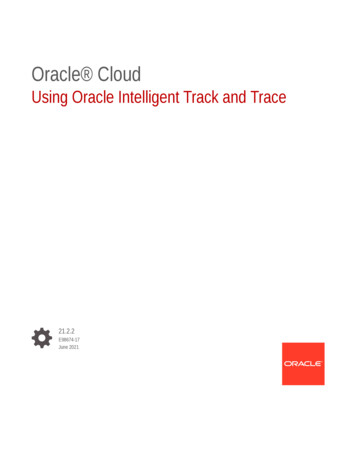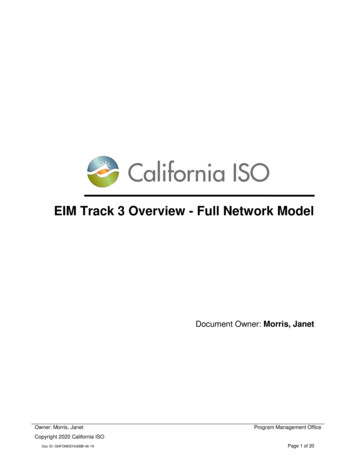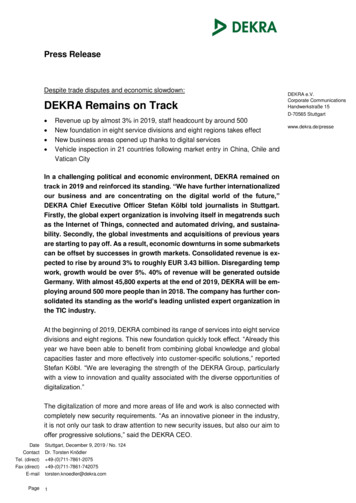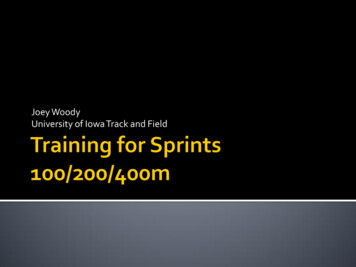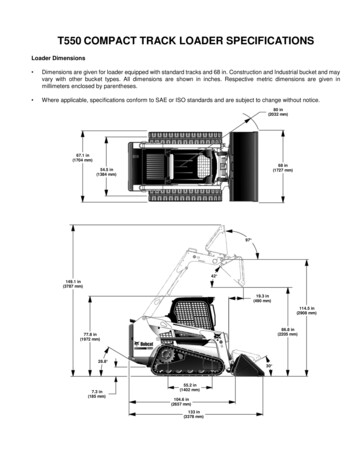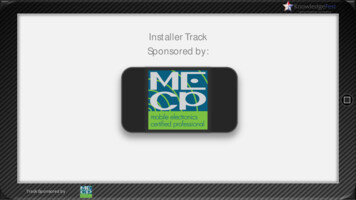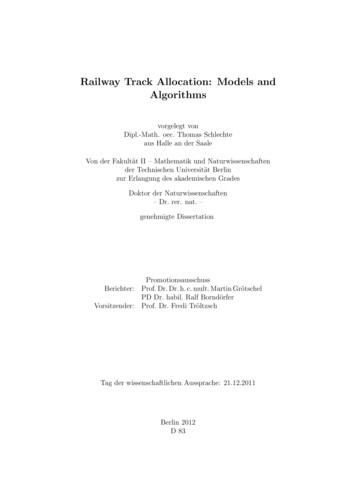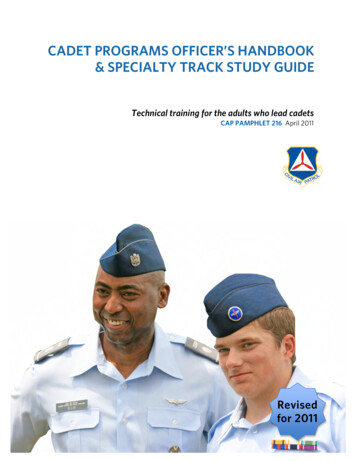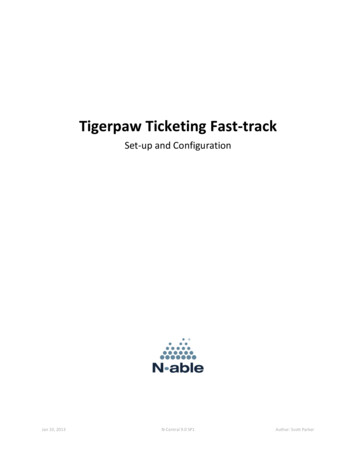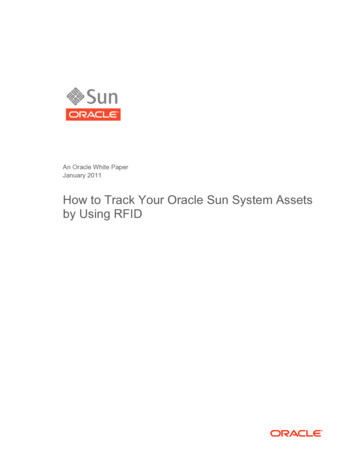
Transcription
An Oracle White PaperJanuary 2011How to Track Your Oracle Sun System Assetsby Using RFID
How to Track Your Oracle Sun System Assets by Using RFIDDisclaimerOracle Inc acquired Sun Microsystems Inc. on February 14, 2010. Some activities in this whitepaper occurredprior to Oracle Inc.’s acquisition of Sun Microsystems, Inc.
How to Track Your Oracle Sun System Assets by Using RFIDIntroduction . 1History of RFID . 2Benefits of RFID for Asset Tracking. 2How Does RFID Work. 3What Does an RFID Tag Look Like? . 3Visual Comparison of Common RFID Tags. . 4RFID Readers . 5Sample IT Asset Lifecycle. 5Asset Tracking With RFID. 7How to Get Started with Computing Asset Tracking Using RFID . 7RFID Security. 9Reprogram the Tag . 10Permanently Disable the Tag. 10Remove the RFID Tag . 10RFID Standards Organizations . 11EPCglobal . 11Financial Services Technology Consortium . 11FSTC RFID Tag Requirements. 12Oracle RFID Tag Encoding . 12Conclusion . 14Tips & Tricks for Common RFID Problems . 15Glossary . 16
How to Track Your Oracle Sun System Assets by Using RFIDIntroductionRadio Frequency Identification (RFID) is a method for identifying objects using low-rangewireless radio frequencies. RFID has been used for more than two decades to improvebusiness efficiencies in supply chain, transportation and inventory management across manycommercial industries as well as in government.Oracle has written this paper to assist our customers in understanding the new 2nd generationRFID tags that are being shipped on every Oracle hardware product.This paper will explain how the RFID technology works, the context for which our tags weredeveloped, the standards they adhere to and how to leverage them to augment your IT assetmanagement lifecycle.1
How to Track Your Oracle Sun System Assets by Using RFIDHistory of RFIDRFID has been around for many decades. It became commercially mainstream technology in the early2000s when retailers like Walmart, Home Depot, Target and Lowes mandated that their top suppliersbegin affixing RFID tags to pallets and crates of merchandise. Over time, as the cost of the RFIDtechnologies dropped and the range and function of the technologies expanded, RFID has been usedto tag and track animate and inanimate objects in ever evolving ways.From livestock to telephones, practical uses for RFID are limited only by the imagination. RFID is aroutine technology used around us every day. Examples of how RFID isused below; Passports Healthcare – patient, hospital tracking Livestock management Access and tolls to buildings, transportation, bridges and roadways. Government inventory and logistics Inventory and supply chain management from supplier to checkout Corporate Asset trackingIn the latter half of 2000s, several large banking institutions facing rigorous Sarbanes Oxley regulations,requested the Financial Services Technology Consortium (FSTC) to define standards for using RFIDas an augmentation to the automation capabilities that barcodes provided.To benefit our customers, Oracle decided to include RFID tags on all server and storage products tofacilitate automated asset tracking.Since the FSTC proposed standard was for US markets only, Oracle worked with partner RCDTechnology to incorporate not only US radio frequency bands, but expanded the RF ranges of the tagto simultaneiously support US and Itinternational frequeny bands. This makes the RFID Oracle taguniversally effective.The RFID tag used by Oracle is a superset of the FSTC standard. The Oracle RFID tag meets FSTCrequirements, Department of Defense (DoD) requirements as well as the EPCglobal Specifications.Benefits of RFID for Asset TrackingOne of the large financial institutions set up a pilot project using RFID and reported an increase inaccuracy of 15% over using bar codes and also reported that the time to inventory one isle of their datacenter went from 2 hours to 1 minute. In summary the benefits of using RFID to track IT assets are: Improves accuracy of current asset inventories Eases labor requirements of inventory and location processes2
How to Track Your Oracle Sun System Assets by Using RFID Enables detection and recording of asset movement and location Enables reduction in operational expenses Enables loss detection and often aids in loss preventionHow Does RFID WorkRFID enables identifying information to be transmitted from a very small specialized tag via low-rangeradio waves to a nearby reader that collects the data.Figure 1. RFID: How it works.What Does an RFID Tag Look Like?RFID tags are typically small labels, rigid or flexible, that provides its contents (identificationinformation) via short distance radio waves to an RFID reader or sensor. The RFID tags, dependingon their purpose, can be battery powered, passive or a hybrid. RFID tags that defined as passive, donot have their own power source. Passive tags must be energized by an energizing device in order forthem to have sufficient power to transmit their contents. Oracle RFID tags are passive. They onlytransmit their contents when an energizing reader is within the 6 to 9 feet required.The tags designed for use on the Oracle products had to fit within a specific size envelope( 36x10x5mm), be able to respond while attached to either a metal or plastic surface and meet thedistance and read velocity requirements specified by the FSTC. While the battery powered and hybridtags would likely meet the distance requirements, they are simply too large to be accommodated on thefront surface of many of Oracle’s products without adversely blocking airflow.Other passive tags, such as an EPIC tags shown below, although commonly used for retail andmanufacturing supply chain management do not respond when attached directly to a metal surfacemaking them unusable on most IT assets.EPIC tags are also too large to fit on the front of many IT products.3
How to Track Your Oracle Sun System Assets by Using RFIDVisual Comparison of Common RFID Tags.RFID tags come in many form factors and each serves a different purpose. Below you will see picturesof tags that were designed for retail and manufacturing purposes. These tags, although not suitable forthe typical IT asset, are still widely used in their domains.EPIC TagThe most commonly used RFID Tag in retail and manufacturing is the EPIC tag.(shown to the left). These are widely adopted, but unfortunately would not properlyenergize when attached to a metal or metal-backed surface, which most IT assetshave.Oracle 1st Implementation RFID TagOracle’s 1st implementation RFID tag was fine for its time but ill-suited to meet thechanging requirements from EPCglobal and the Department of Defense (DoD). Thistag would only respond and communicate with readers designed for the United Statesfrequency bands. It was shipped very briefly and was quickly replaced with the 2ndimplementation tag to support global standardization.Oracle 2nd Implementation RFID TagIn 2010, In order to meet the operational needs of RFID for IT asset management in typical datacenter usage scenarios, Oracle selected the globally usable, metal-attachable, FSTC compatible, Tagmanufactured by RCD TechnologyTo the left, is a picture of the rigid multi-band RFID tag shipped on the frontof Oracle products. This tag is consistently applied to the front of theequipment and is readable by a portable or stationary RFID reader within a 9FT range in all global radio frequency bands.Comparison for Dipole Alien Tags and RCD Sentry-M WW TagsTo the right is an internal view of an Alien dipoletag alongside an Oracle tag. The dipole tag isflexible and is used heavily in supply chain andinventory processes. Besides its obvious physicaldifferences, it did not meet the functional requirements needed for a global IT asset tracking devicenor does it work when affixed to metal objects like servers and storage devices shipped by Oracle.Like the EPIC tag, Alien’s Dipole tags are widely used in many other tracking scenarios.4
How to Track Your Oracle Sun System Assets by Using RFIDRFID ReadersRFID readers (also called sensors) are manufactured and sold by many vendors and come in two formfactors: stationary and mobile. In some cases assets may be tracked and managed with both forms ofreaders.Stationary ReadersStationary RFID readers are often mounted at all entrances and exits to a data center facility. The actof moving an asset with an RFID tag through the portal causes the RFID tag to be energized and thenread by the reader. The reader records the item and movement (including direction) typically to anetwork repository, where the information is available for programmatic use.The detection of the asset passing through the sensor field would be logged as an event in the datarepository, then the software framework in place to manage the events would handle notifying all theupstream enterprise systems such as help-desk systems, ticketing systems and other asset managementsystems.Sample IT Asset LifecycleBelow is a numbered diagram that is followed by a numbered narrative that should help illustrate howa data center can be fitted with stationary RFID readers to track which assets come in and which assetscome out.Figure 2. Sample asset flow through data center using stationary readers. (stationary readers are often called portalreaders)RFID tagged asset would pass through the RFID sensors at an entrance. The sensors would firstenergize the tag, and the tag would transmit its unique EPC code via radio waves. The sensors wouldreceive the EPC transmission from the tag and would log an event with the EPC code, the direction ofthe movement and location of the tracking event to the RFID data repository.5
How to Track Your Oracle Sun System Assets by Using RFID1.The asset would enter the data center2.The asset would be installed within the facility, usually a rack.3.A year or two later the asset may move to another rack within the facility.4.The asset is removed from the facility where again, the sensors energize the RFID tag, the tagtransmits its unique EPC code via radio waves. The portal sensors would receive the EPCtransmission from the tag and would log an event with the EPC code, the outbound directionof the movement and door location to the repository.With the use of software, hybrid usage of door sensors combined with mobile readers (not depictedabove) can yield an overall set of event data that supports reconciliation and location of assets at anypoint in time.Mobile ReadersMobile Readers come in various configurations with different types of antennas, different powerprofiles and different ranges of use. Many support 2D barcode scanning as well as RFID tag reading.Hand-held units use about half the power of a stationary reader and therefore read from a shorterdistance. To make up for the distance limitation some readers are available with a polarized antenna,however, this requires the orientation of the reader to be in the same plane as the tag. Circular antennasare able to read the tag regardless of orientation, however, these antennas work from a shorterdistance.If you use a hand-held reader, make sure you choose the right one for your needs.In the picture below, a cart-mounted stationary reader is transformed into a mobile asset trackingmachine by adding a laptop to capture the data from the RFID reader which is powered by a batterymounted on the cart. The reader is pushed along the front of computer racks, where the asset-affixedRFID tags are energized and transmit their EPC codes. The RF information is collected and stored ina local repository on the laptop. Once local to the laptop, it can be transferred to other systems forreconciliation, inventory updates etc.6
How to Track Your Oracle Sun System Assets by Using RFIDFigure 3 Cart-mounted RFID reader with four antennae being rolled down IT aisles, collecting real time inventory data.Note: Some people have an unfounded fear that the RFID transmissions from the RFID tags orthe RFID Reader could cause running servers to crash. Oracle server and storage productsare designed to be resistant to radio frequency energy fields. Oracle products are routinelytested for energy fields much greater than the signal strength of an RFID reader or the tag.Asset Tracking With RFIDHow to Get Started with Computing Asset Tracking Using RFIDRFID usage can range from simplistic asset inventories using a single mobile device to completefabrics of stationary and mobile readers working in concert to inventory and track and locate assetswhenever needed.This document assumes that if you have RFID technologies already available to you in your enterprise,that you will follow your enterprise’s architectural framework. EPCglobal publishes a publicallyavailable Architecture Framework Reference Model that is a great starting point for establishing yourown enterprise architecture and to which most RFID vendors comply.7
How to Track Your Oracle Sun System Assets by Using RFIDFigure 4 EPCglobal Architecture FrameworkThe EPCglobal Architecture Framework was created to enable customers to quickly utilizeEPCglobal's standards within their enterprise and expose those interfaces to other parties. UsingEPCglobal’s framework provides you with out-of-the-box integration with many edge-ware vendors.Oracle’s complete RFID partner list can be found at s.htmlIf you are new to RFID, you may be surprised to learn how easy it is to utilize the rudimentarycapabilities of RFID for inventorying your assets and creating a data repository for asset management.The processes below describe a sample process to collect Oracle RFID and product serial numberinformation together.Tools Needed for Semi-Manual Inventory Process An RFID reader and its control software. Local data repository (typically a laptop or PC)It will be much simpler for your asset management staff if they are provided an RFID reader thatminimally supports the following features; RFID UHF Gen1 and UHF Gen2 compatible RFID programming 2D Barcode scanning Data collection and intuitive correlation of EPC with other inputs Data output in spreadsheet format (i.e., .csv)8
How to Track Your Oracle Sun System Assets by Using RFID Customizable input fields such as Rack, Location, Business Unit, etc Laptop (if/as required by the RFID reader you choose)Sample Inventory Collection Process upon Receipt1.Read about and configure your RFID Reader. (See Tips and Tricks Section for advice on howto set the field focus and to orient for your reader’s antenna.)2.Configure your reader software package to support custom fields you would like to collect forthe initial data collection along with the RFID Tag EPC number. (i.e asset owner, locationidentifiers such as rack and row numbers, cage number etc.)3.For best results, place the RFID reader within 6 ft of the RFID tag on the front of thehardware and search for RFID Tags. If you are near other devices with RFID tags, you willneed to select the right one for your device (read the label on the tag if you to discern fromseveral) then store it.4.Your reader, as you configured in step 1a, will prompt for other fields including the serialnumber of the product which can be scanned with the barcode reader, or typed in by readingthe Customer Information Sheet that ships with each Oracle hardware product.5.Once the data field are stored together, the data can be exported for input into other systems.6.Once the correlated data has been stored in an upstream database, future inventories will onlyrequire the collection of the EPC which can be used to access the other stored informationsuch as the serial number and location of asset.7.Typically the most efficient way to do point-in-time inventories of your data center, is to rowby-row, open the front doors of your racks, and walk a mobile reader down the aisle, anddiscover all the RFID tags for reconciliation.RFID SecurityBy its nature, RFID technologies in use today are not secure. RFID transmissions are subject to closerange eavesdropping. RFID tags can be energized and read within a 6 to 9 foot proximity.RFID is provided as a convenience to our customers who wish to use it. If RFID is prohibited in yourenterprise, one of these three options exists for you to disable or remove the RFID tag from Oracleproducts.1.Reprogram the RFID tag2.Permanently disable the RFID tag’s RF transmission capability3.Physically remove the RFID tag (along with the complimentary barcode and DoD labels)9
How to Track Your Oracle Sun System Assets by Using RFIDReprogram the TagIn order to reprogram the RFID tag, you will need a reader that also supports reprogramming the tag.Since the RFID tag is passive, the reader will energize it in order to be reprogrammed, so be sure toplace the reader in very close proximity before attempting to reprogram a tag.The tags used on Oracle equipment are logically locked, and they must be unlocked in order toreprogram the tag.1.Put the reader in program mode2.Select the tag you wish to re-program3.Give the reader the command to Unlock the EPC4.Enter the new EPC that you wish to program into the tag5.Give the reader the command to Program the EPC6.Give the reader the command to Lock the EPCPermanently Disable the TagIn order to permanently disable the RFID tag, you will need a reader that also supports the tag KILLcommand. As in the reprogramming sequence above, be sure to place the reader in very closeproximity before attempting to kill the tag.The tags used on Oracle equipment are logically locked; they must be unlocked in order to Kill the tag.The tags used on Oracle equipment do not have a Kill password programmed into the device, a Killpassword must be programmed into the device before the device will accept the Kill command.1.Put the reader in program mode2.Select the tag you wish to Kill3.Give the reader the command to Unlock the Kill password4.Enter the Kill password of your choice5.Give the reader the command to program the Kill password6.Give the Kill command three consecutive timesRemove the RFID TagMost enterprise customers will never have a reason to remove an RFID tag. There are some instanceswhere removal is desirable and the process to safely remove the tag is outlined here.Beware, as there are implications of removing the tag.The label on surface of the RFID tag includes the printed serial number of the product as well as 2Dbarcodes. Removing the RFID tag removes the barcodes and also eliminates the front accessible10
How to Track Your Oracle Sun System Assets by Using RFIDequipment serial number. Although the product serial number can still be read of
To benefit our customers, Oracle decided to include RFID tags on all server and storage products to facilitate automated asset tracking. Since the FSTC proposed standard was for US markets only, Oracle worked with partner RCD Technology to incorporate not only US rad
